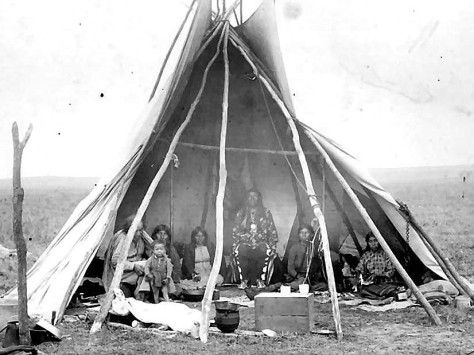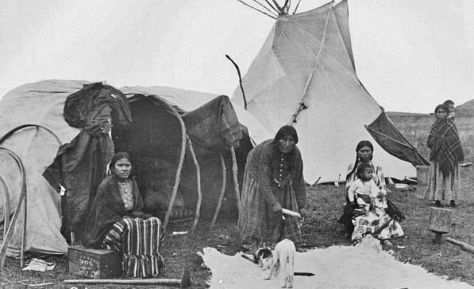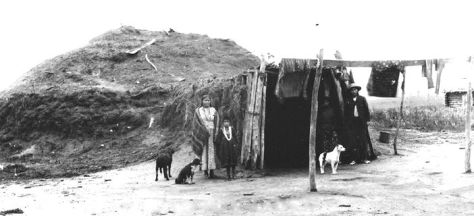After Pipe Chief came of age, inspired by his friend Spotted Horse, he endured the ordeal of initiation into his chosen fraternal society. “I was of those who looked at the Sun and the Moon,” he said, telling the story to George Bird Grinnell one night long ago in Pawneeland. He soon joined a raiding expedition led by Spotted Horse. They traveled up the Flat River and down the south fork to the foothills of the Distant Rocks in a Line. There they found the Sáhi, and they captured 300 horses.
Pipe Chief was born about 1836, so this memorable event in his youth probably happened during the 1850s. He eventually became a priest and leader among the Skidi. A man who went by that name appeared in several photos taken around 1870. I don’t know if he was this particular Pipe Chief since versions of that name were held by different men. But I have lately become aware of a photo that can be identified with more certainty as Pipe Chief. It was taken just a couple years after he told the story of his youth to Grinnell.
It is not certain what year William Prettyman and his apprentice George Cornish took the photo. Most descriptions of the photo say 1889. But this is too early. Internal evidence tells us that it was more likely taken in late 1890 or early 1891. The scene shows an open tipi with seven people inside. Four women sit on the ground; two men have seats of some kind; a young child stands in front of one of the men.

In 1891 Prettyman apparently sent a print of this tipi portrait with several others to the Bureau of Catholic Indian Missions at Marquette University. It bore a caption: “Tepee Indian Summer House.” If this accession information is accurate, it frames the latest possible date for the image as 1891.
The print entered the collections in company with another photo taken during the same period. This second photo showed four women and two children in a camp. There is a tipi and a tent and a caption: “Pawnee Indians, Located 70 Miles South of Arkansas City.” Three of the women and one of the children can also be seen in the other photo, the tipi portrait. In 1895 the camp scene was published in a book by George Bird Grinnell, The Story of the Indian, captioned as “Pawnee woman dressing a hide.”

The tipi portrait can be found on the website for the Oklahoma Historical Society where it is identified as a photo taken in 1889 by Prettyman and Cornish, showing Pawnees in a tipi with Baptiste Bayhylle. Studying a magnified version of the image, an old man can indeed be made out, partially obscured by a tipi pole – he does look like Baptiste Bayhylle. A child stands in front of his knees. One of the women is peering over at them.
Then I found the same two photos on the website of an auction house. Cowan’s Auctions offered for sale an albumen print of the tipi portrait photo, and this print featured a handwritten caption, “Pipe Chief & family” with the date “1889” written in another hand. Another note appeared in pencil, perhaps in the same hand as the 1889 date: “Ben Gover and mother at left of Pipe Chief.”
The writing is faint. We have no indication of who wrote this information or when it was set down. Prettyman and Cornish made prints from their plates. In this case they used the albumen process to create the images that ended up in the hands of the Cowan auctioneers – the process used silver nitrate; gold was used for toning. These Cowan versions both come with interesting caption information.
The image showing a camp scene with four women and two children has a pencil inscription on the verso: “Mrs. Lizzie Leading Fox; & mother Mrs. Sky Seeing [with a Cowan note stating she is using “an implement of elk antler with a steel blade to chip the dried cow hide to an even thickness…”]; Mrs. Clora Gover Yellow Horse and Ben Gover; and Harry Coon’s aunt.” There are also two pencil inscriptions on the recto margin: “Harry Coons” and “Mose Yellow Horse” with an arrow pointing toward “Clora” and “Harry Coon’s aunt.”
This information is interesting and puzzling. Clara has been identified by some as the mother of Mose Yellow Horse, though she might have been his stepmother. But since he was born about 1897, he was not the infant child in the photo. Someone wrote his name on the print after that date, well after the photo was taken. The unnamed woman, “Harry Coon’s aunt,” appeared in both photos.
Harry Coons Jr was born about 1895, the son of Harry Coons and Belle Coons, and Belle had a sister named Stah-kah Coons. Stah-kah was the first wife of Harry Coons and she could be the unnamed aunt – she was in fact the aunt of Harry Coons Jr. But the only information I have about her is a vague report that she died about 1887. If we discount this vague information and theorize that she was still alive in 1890-1891, then Stah-kah Coons could be the aunt in question.

The Leading Fox earthlodge, with Lizzie and daughter Mattie
So the camp scene includes Lizzie Leading Fox, Kate Sky Seeing, Clara Ricketts and Ben Gover, and maybe Stah-kah Coons with an infant – perhaps Lizzie’s daughter Mattie. And the tipi portrait includes Baptiste Bayhylle, seated with Ben Gover at his knees; Kate Sky Seeing, seated behind Bayhylle; Susie Lockley Pipe Chief Garcia, sitting beside Kate; Susie’s husband Pipe Chief, wearing his medallion; Clara Gover Ricketts Yellow Horse, sitting on the ground to his left (she is the mother of Ben Gover); and the final person might be the aunt of Harry Coons Jr, Stah-kah Coons.
These two gatherings of Skidis occurred sometime in 1890-1891. Bayhylle was then about age 60 – we can guess that he was on hand to help interpret for Prettyman and Cornish. Kate Sky Seeing was about age 48 in 1892, married to a Skidi named Osage Sky Seeing. In 1891 Clara Ricketts had just been married to one of the Govers and had a son named Ben. “Ricketts” might have been her maiden name – at least, she went by that name at the time the photo was taken. She next took up with Thomas Yellow Horse. They raised a son named Mose who went on to become a famous baseball player. The mysterious aunt of Harry Coons… if the woman is Stah-kah Coons, we know that she died very soon after the two photos were taken. Susie Lockley was born about 1861 and she became the fifth wife of Pipe Chief. They had a daughter named Nellie who married Frank Murie and then John Jake. Pipe Chief died in 1898, and by 1914 Susie had become Susie Garcia. All this happened in Pawneeland.
Pipe Chief was a ceremonialist. James R. Murie wrote down an account of the Skidi New Fire Ceremony, mentioning Pipe Chief and his friend Spotted Horse. It is a detailed memoir of a ceremony that might have been held last during the early 1870s. In the course of the preliminary sequence of activities, Pipe Chief conducted a smudge of some sacred objects, an offering of “sweet-smelling smoke to Tirawahat.” He finished that rite and then he “passed his hands through the smoke and down his body and returned to his place.” He sat down as the offerings continued, the preparations for the New Fire Ceremony in Pawneeland.
And during the fall the Skidis left their earthlodge city and set up their tipis and they hunted. And in the spring in their earthlodge city, after the distribution of seeds, after the doctor dances, then would follow the New Fire Ceremony. The Skidis would offer gifts to the stars; gifts to the sun and moon. They would enact the creation of life in the world. And if they wished, they would take new names. All of these things happened long ago in Pawneeland.
